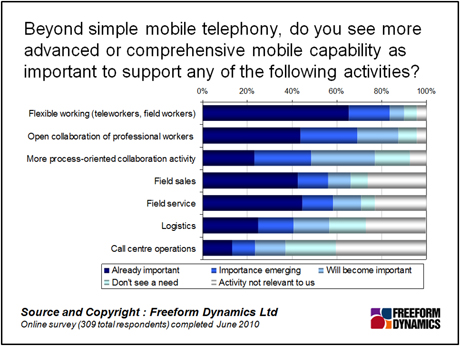Most businesses tend to find themselves arriving at a point where they have accumulated a bunch of mobile stuff. Some of it has been brought into the business in a premeditated fashion, while other bits have crept in, in response to personal or group pressure.
We can argue that there is nothing necessarily wrong with this, it is just how things have happened. But what this will invariably lead to is a spectrum, in terms of how appropriate everything is and how well it will all perform. At one end, there will be stuff that has been well designed and implemented, and is well supported. At the other end, the company will be running with things that are just not useful, and that take a lot of time and resource to support. And somewhere in the middle will be services or kit that have the potential to be very useful, but are not proving to be, because they have not been well implemented, or have been simply bolted on to existing systems.
Of course, even if things are fairly fragmented, they will probably still work. Irrespective, it makes sense for businesses to draw up an inventory around mobility, taking into account the status quo, and building on that, focussing on where the business wants to be and, importantly, how it will get there. This is not a trivial task: there is probably already a great deal of complexity within the business, and there may be a potentially large gap between what the business ultimately needs and wants to achieve with mobile, and what IT can deliver, from a resourcing, technical and cost perspective.
But why should businesses bother now? After all, it hasn’t really been an issue up to this point, even if things have been a bit flaky round the edges, has it? There are two primary reasons.
First and foremost, continuing with a disorganised approach, irrespective of how that has been arrived at, is quite simply a cost to the business, requiring additional resourcing and continual refinements to ‘keep things running’. If your company is one that is happy to wave a magnanimous hand over resources leaking away in this way, then lucky you, particularly in the current economic straits. Most companies won’t fit into this category, however.
Secondly, and this is probably the most important, demands from businesses in terms of mobile and mobility are growing rapidly. Witness the increasing shift to remote working, and the additional mobile component that requires, as an example of this. More and more, business managers are looking at the value of mobile in the business context, with a view to implementing a wider array of solutions, such as extending unified communications to mobile devices, or providing mobile access to CRM systems for sales and service staff out in the field. The chart below, taken from the recent poll with Reg readers, illustrates how mobile is already critical in supporting a wide range of business activities for many companies. And even where mobile isn’t yet critical to a company, where the activities are relevant to the business, most see the need for mobile as a support, moving forwards.

If your company is already sitting on a mobile mess, then adding to it, in the way that many of you tell us that you are going to do, without sorting out your current problems first, is a potential recipe for an IT nightmare. And it is probably little more than wishful thinking that the business will give you the necessary breathing space to untangle your IT problems once the management has decreed that a certain set of mobile applications have become critical.
This ‘need’ to look seriously at mobile doesn’t mean that all the problems need to be solved overnight. Even if they could be, it is not advisable, as some issues may be addressed simply by dint of dealing with others, and so, won’t need a specific plan against them. Rather, it makes more sense to prioritise where effort will be placed. So, for example, if mobile email is critical to the business, but somehow, the company has found itself working with several different email approaches – e.g. BlackBerry, Windows Mobile and iPhones, then the nut to crack would be how to put together a core which is robust enough to handle the different devices, but that is sufficiently easy to manage.
Part of this evaluation of what mobile is to the business involves assessing, in the cold light of day, how, where and when any new solutions might fit into the business going forward, from both a business and a technical perspective. This will, to some extent avoid a re-run of the current situation where implementations have been uncoordinated and fragmented.
What is the state of mobile in your business? Are you constantly pushing, or even being pushed to the bleeding edge, and if so, what are the pitfalls? Are you trying to unravel the tangled web that has become your mobile world? Or have you tackled the issue head on and come out of the other end with stories to tell. Whatever your situation, we’d be interested in hearing about your experiences.
Content Contributors: Josie Sephton